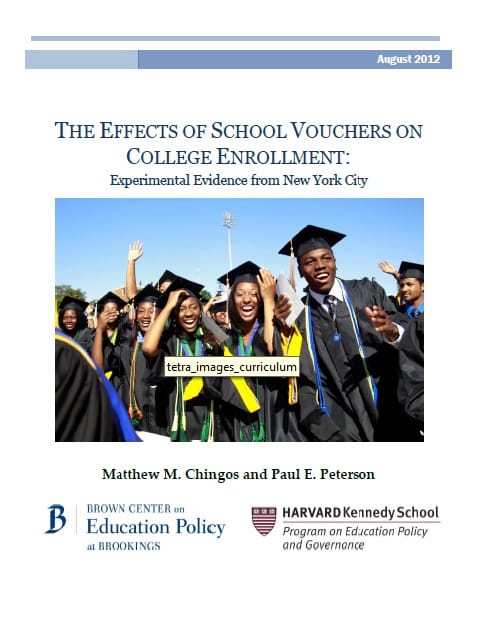 School-choice advocates have touted results of this recent study—a joint publication of the Brown Center on Education Policy (Brookings) and the Program on Education Policy and Governance (Harvard). And they have every right to: The random-assignment study (a gold standard of research often elusive in school-choice research) boasts some strong findings for choice supporters. The study began in 1997 when Harvard’s Paul Peterson began tracking students who applied for a new privately funded voucher program in Gotham. Created after Cardinal John O’Connor invited then-school chancellor Rudy Crew to “send the city’s most troubled youth to Catholic schools,” the program offered three-year vouchers of $1,400 per year to 1,300 low-income youngsters. Peterson tracked participants as well as those who did not win the lottery. Fifteen years later, Peterson, along with Brookings’s Matt Chingos, show that black elementary school students who won the voucher lottery in New York City were 7 percentage points (or 20 percent) more likely to attend college than their peers who didn’t. Moreover, the percentage of black voucher students who attended a selective college was more than double that of black non-voucher students. (There were no significant differences for white or Hispanic pupils.) Not too shabby for a program that cost just $4,200 per pupil over three years.
School-choice advocates have touted results of this recent study—a joint publication of the Brown Center on Education Policy (Brookings) and the Program on Education Policy and Governance (Harvard). And they have every right to: The random-assignment study (a gold standard of research often elusive in school-choice research) boasts some strong findings for choice supporters. The study began in 1997 when Harvard’s Paul Peterson began tracking students who applied for a new privately funded voucher program in Gotham. Created after Cardinal John O’Connor invited then-school chancellor Rudy Crew to “send the city’s most troubled youth to Catholic schools,” the program offered three-year vouchers of $1,400 per year to 1,300 low-income youngsters. Peterson tracked participants as well as those who did not win the lottery. Fifteen years later, Peterson, along with Brookings’s Matt Chingos, show that black elementary school students who won the voucher lottery in New York City were 7 percentage points (or 20 percent) more likely to attend college than their peers who didn’t. Moreover, the percentage of black voucher students who attended a selective college was more than double that of black non-voucher students. (There were no significant differences for white or Hispanic pupils.) Not too shabby for a program that cost just $4,200 per pupil over three years.
SOURCE: Mathew M. Chingos and Paul E. Peterson, The Effects of School Vouchers on College Enrollment: Experimental Evidence from New York City, (Washington, D.C.: Brown Center for Education Policy at Brookings; Cambridge, MA: Harvard Program on Education Policy and Governance, August 2012).
A version of this analysis appeared on the Choice Words blog.
